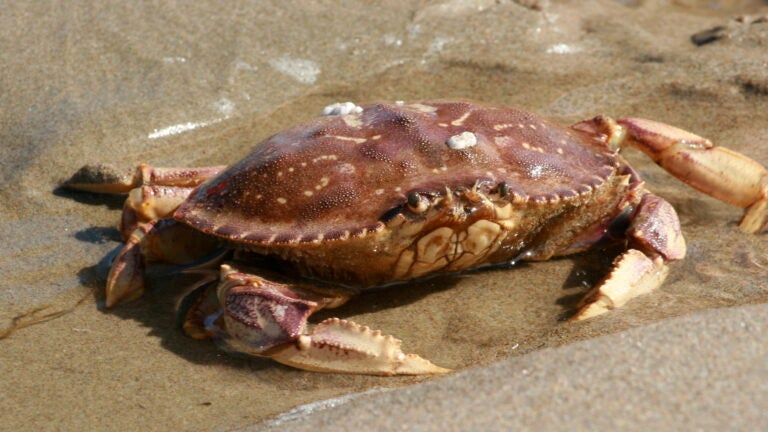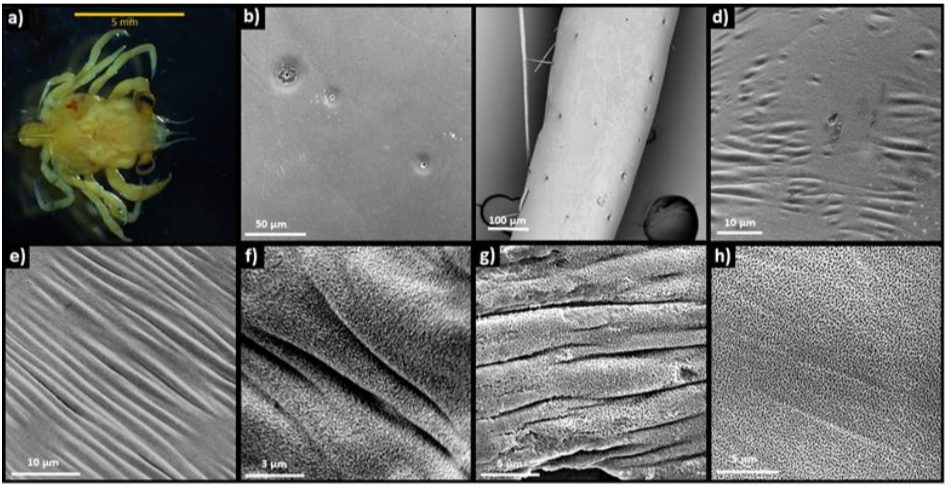
A Dungeness Crab off the coast of San Francisco Bay. Source: Colleen Proppe, CC BY-NC 2.0.
Forecasting the Future of Dungeness Crabs
The Dungeness crab lives a life of mystery.
This iconic crab drives one of the most lucrative fisheries on the U.S. West Coast, totaling over $200M in 2017[1]. Yet, the size of the Dungeness fishery mysteriously and dramatically fluctuates from year to year. This fluctuation presents a considerable challenge for resource managers and Dungeness harvesters planning for the year ahead.
What if there were a way instead to forecast the size of the Dungeness fishery years in advance? Scientists funded by USC Sea Grant are building the research tools to do just this.
Dr. Nina Bednaršek is setting her sight on the Dungeness crabs of the future by turning to the Dungeness youth of today. The amount of young Dungeness in a given year is a strong predictor of the size of the Dungeness fishery in years to come. Dr. Bednaršek’s team has found that the fate of these young crabs can be predicted by the ocean conditions experienced as they grow[2].

Below the surface, the ocean has a rhythm with a daily and seasonal beat. Every day, young crabs swim incredible distances to eat at the ocean surface at night and escape back to the ocean depths in the morning. The ocean deep provides safety from predators, but at a considerable cost.
Dr. Bednaršek has found that the deep water off the U.S. West Coast is becoming more acidic as global atmospheric carbon dioxide increases. Her team witnessed how these acidifying waters corrode the shells of young crabs swimming in their midst[3]. Springtime brings a shift in winds that draws this deep, acidic water to the surface, further exacerbating stress on young crabs. Such acidification has made the ocean’s natural rhythms increasingly dangerous for young Dungeness crabs and other marine organisms.

What can be done to ensure the future of the Dungeness crab fishery?
Dr. Bednaršek’s team has taken a critical first step by mapping ocean acidification “hotspots” along the U.S. West Coast that present the most risk to young crabs and providing a better understanding of those ocean conditions that support the survival of young Dungeness crabs. With these foundational tools, resource managers have a stronger chance of preserving this iconic species and the livelihoods that depend on them.
There is still work to be done. Continued efforts by Dr. Bednaršek and the USC Sea Grant Program will uncover the most sensitive Dungeness habitats and support longer-term crab forecasts to better inform fishery management. Bit by bit, this research is moving us closer to uncovering the mystery of the iconic Dungeness crab.
References
[1] Pacific States Marine Fisheries Commission, Species Report: Commercial Land Catch: Metric-Tons (mt), Revenue, and Price-per-pound (Price/Lbs), 2019, Portland, OR: Pacific States Marine Fisheries Commission
[2] Norton Emily L., Siedlecki Samantha, Kaplan Isaac C., Hermann Albert J., Fisher Jennifer L., Morgan Cheryl A., Officer Suzanna, Saenger Casey, Alin Simone R., Newton Jan, Bednaršek Nina, Feely Richard A.,The Importance of Environmental Exposure History in Forecasting Dungeness Crab Megalopae Occurrence Using J-SCOPE, a High-Resolution Model for the US Pacific Northwest, Frontiers in Marine Science, 7, 2020, ISSN 2296-7745, https://www.frontiersin.org/article/10.3389/fmars.2020.00102
[3] Nina Bednaršek, Richard A. Feely, Marcus W. Beck, Simone R. Alin, Samantha A. Siedlecki, Piero Calosi, Emily L. Norton, Casey Saenger, Jasna Štrus, Dana Greeley, Nikolay P. Nezlin, Miranda Roethler, John I. Spicer, Exoskeleton dissolution with mechanoreceptor damage in larval Dungeness crab related to severity of present-day ocean acidification vertical gradients, Science of The Total Environment, Volume 716, 2020, 136610, ISSN 0048- 9697, https://doi.org/10.1016/j.scitotenv.2020.136610